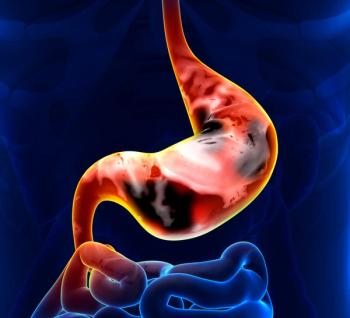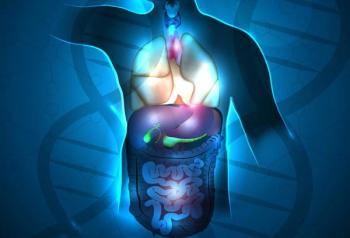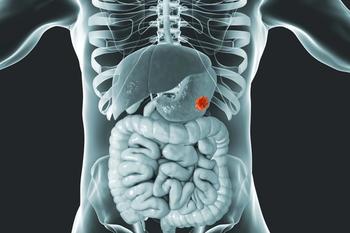
- ONCOLOGY Vol 11 No 9
- Volume 11
- Issue 9
The UFT/Leucovorin/Etoposide Regimen for the Treatment of Advanced Gastric Cancer
Gastric cancer is the most chemosensitive adenocarcinoma among digestive neoplasms. A few years ago, we performed a phase II trial with the FLEP regimen, in which fluorouracil (5-FU) and leucovorin are combined
ABSTRACT: Gastric cancer is the most chemosensitive adenocarcinoma among digestive neoplasms. A few years ago, we performed a phase II trial with the FLEP regimen, in which fluorouracil (5-FU) and leucovorin are combined with etoposide and cisplatin (Platinol). This regimen resulted in a 39% response rate and high toxicity. Then we used the combination UFT (tegafur and uracil)/leucovorin/etoposide: UFT 390 mg/m2/day orally on days 1 to 14; leucovorin 500 mg/m2 IV day 1, and 15 mg/12 h orally on days 2 to 14; and etoposide 100 mg/m2 IV on day 1 and then 200 mg/m2/day orally on days 2 and 3. Forty-six patients received a median of five courses. Five patients (11%) achieved a complete response and 12 (26%) a partial response, for an overall response rate of 37%. The response rate was 50% in patients with an Eastern Cooperative Oncology Group performance status of 0 to 1. Grades 3 to 4 toxicities appeared as follow: 17% of patients had diarrhea, 11% had nausea/vomiting, and 13% of patients had anemia. One patient died of neutropenia and sepsis. The median survival time was 9 months. In summary, UFT/leucovorin/etoposide is effective and moderately toxic in patients with advanced gastric cancer. A new trial with UFT/leucovorin/epirubicin is ongoing.[ONCOLOGY 11(Suppl 10):109-112, 1997]
Gastric cancer is the most chemosensitive adenocarcinoma among the digestive neoplasms. Most chemotherapy regimens include 5-FU, which remains the mainstay for treatment of this tumor. The activity of 5-FU can be enhanced through modulation with leucovorin.[1,2] For this reason, our cooperative group has focused on fluoropyrimidines modulated by leucovorin as therapy for advanced gastric cancer.
In 1989, Preusser et al[3] reported a 57% response rate with the FLEP regimen-5-FU, leucovorin, etoposide, and cisplatin (Platinol). Previous studies had suggested a synergism between cisplatin and etoposide, and some authors had reported interesting response rates with either of the two combinations: etoposide/cisplatin (EP)[4] or etoposide/doxorubicin (Adriamycin)/cisplatin (EAP).[5] With this background, FLEP appeared to be an attractive schema for the treatment of gastric carcinoma, and it was decided to assess the efficacy and toxicity of FLEP in a phase II trial. The FLEP regimen we used consisted of leucovorin 300 mg/m2/day, followed by etoposide 100 mg/m2/day, 5-FU 500 mg/m2/day, and cisplatin 30 mg/m2/day, all given on days 1 through 3 and repeated every 28 days.
Forty-six patients with locally advanced or metastatic gastric cancer received a median of 3 courses each.[6] Response was not evaluable in 5 patients, 2 patients obtained a complete response, and 16 a partial response, for an overall response rate of 39%. The median duration of response was 5 months. Grade 3/4 toxicities included leukopenia in 9.5% of courses, nausea/vomiting and diarrhea in 4% of each, and anemia and thrombocytopenia in 3% of each.
These results were very similar to those reported by Preusser et al[7] when they updated their series 1 year after the first communication. In summary, FLEP showed moderate activity but at the cost of important toxicity. For this reason we did not recommend it for the treatment of advanced gastric cancer.
Some years ago we performed a phase I trial of UFT comprising tegafur (an oral derivative of 5-FU) and uracil, modulated with leucovorin.[8] The leucovorin was given intravenously on day 1 at a dose of 500 mg/m2 and then orally 15 mg/l2 h on days 2 to 14. The aim of the trial was to find the maximum tolerated dose of UFT taken for 14 days and modulated in this way. This schema had three interesting characteristics: First, the modulation of UFT with leucovorin would enhance its activity; second, oral therapy with UFT could simulate a continuous infusion of 5-FU; and third, the schema allowed ambulatory treatment.
In that trial, the maximum tolerated dose of UFT was 390 mg/m2/day on days 1 to 14, given in two separate doses (before breakfast and before dinner).
Rationale for the Combination UFT/Leucovorin/Etoposide
Several factors support the rationale for the combination UFT/leucovorin/etoposide in patients with gastric adenocarcinoma: First, most patients with advanced gastric tumors receive 5-FU, which has been considered the pivotal drug in combination regimens. Further, several studies indicate an improvement in efficacy with continuous infusion of 5-FU,[9,10] which can be achieved by modulating 5-FU with leucovorin. In theory, the oral administration of UFT for 14 days simulates a continuous infusion of 5-FU. In addition, we have obtained good results with UFT/leucovorin in patients with advanced colorectal adenocarcinoma,[11] and some evidence suggests a synergism between etoposide and fluoropyrimidines.[12,13] For instance, Wilke et al have reported a 53% response rate (12% complete response) in gastric carcinoma patients older than 65 years of age with the regimen etoposide/leucovorin/5-FU.[13]
Patients and Methods
Between March 1993 and December 1994, 46 patients were included in the study. Among the 46 patients, there were 27 males and 19 females. All had histologically confirmed, locally advanced or metastatic gastric adenocarcinoma. Entry criteria included measurable disease, good performance status (Eastern Cooperative Oncology Group 0–2), absence of brain metastases, and no prior chemotherapy or radiotherapy. Participants also were required to have a granulocyte count of 2 × 109/L or greater, a platelet count greater than 100 × 109/L, a serum creatinine level less than 115 µmol/L, a creatinine clearance rate of greater than 60 mL/min, a serum bilirubin level less than 35 µmol/L, and serum glutamic oxaloacetic and serum glutamic pyruvic transaminase levels of less than three times the upper limits of normal, unless alterations were due to tumoral infiltration.
Patient characteristics are shown in Table 1. Almost half (48%) had an Eastern Cooperative Oncology Group performance status of 0 or 1, and most presented with unresectable disease, either due to extensive local infiltration (9%) or metastatic involvement at diagnosis (63%). The remaining patients (28%) had relapses following radical surgery.
After giving informed consent, patients received IV etoposide 100 mg/m2 and IV leucovorin 500 mg/m2, both on day l. They also took oral UFT 390 mg/m2/day (in 2 doses) on days 1 to 14, oral leucovorin 15 mg/12 h on days 2 to 14, and oral etoposide 200 mg/m2/day on days 2 and 3. Figure 1 displays this schema, which was repeated every 28 days for a minimum of three courses. Patients were to be maintained on chemotherapy until progression or unacceptable toxicity occurred.
Participants were told to stop taking oral therapy if they passed 3 or more liquid stools in a day. If this occurred, the dose of UFT/etoposide was reduced by 25% in subsequent courses. A similar reduction was applied in cases of grade 3/4 nonhematologic toxicities. In the case of a neutrophil count less than 1.5 × 109/L or a platelet count less than 100 × 109/L by day 1, treatment was delayed for a maximum of 2 weeks. After that period, if neutrophils remained 1 to 1.5 ×109/L or the platelets 70 to 100 × 109/L, the dose of UFT and etoposide was reduced by 50%; if lower values resulted, chemotherapy was discontinued.
Response was evaluated at the end of every three courses, unless there was evidence of disease progression. Standard definitions for complete response, partial response, and disease progression were used. Response duration and survival were calculated from the first day of therapy until the day of death or last known follow-up. Toxicity was recorded before the next course of treatment and graded according to World Health Organization scales. These scales do not include gastric pain, which may occur with the ingestion of UFT. Therefore, we considered gastric pain to be grade 3/4 if the symptoms required withdrawal of UFT despite administration of antacids and H2-blockers.
The Wilcoxon rank-sum method was used to compare quantitative variables and the chi-square was used for percentages. The duration of response and survival were calculated with the Kaplan-Meier method.
Results
The 46 patients enrolled received a total of 232 cycles of treatment, with a median of 5 cycles per patient (range: 1 to 14). Two patients were given just 1 course; 1 patient died as a result of toxicity, and the other decided to discontinue chemotherapy.
Five patients achieved a complete response (11%) and 12 a partial response (26%), for an overall response rate of 37% (95% confidence interval, 22% to 51%). This rate varied according to the performance status (PS): There was a 50% response rate among patients with Eastern Cooperative Oncology Group PS 0-1 and a 21% response rate for those with Eastern Cooperative Oncology Group PS 2. The median duration of response was 10 months. With regard to the site of metastases, the response rate was 42% for those with liver metastases, 33% each among those with lymph node and peritoneal metastases, and 11% for patients with lung metastases. The median overall survival was 9 months for the total population and 13 months for responders (Figure 2).
Diarrhea, nausea/vomiting, and anemia were the main side effects seen, as shown in Table 2. The anemia was not related to either the presence of a local tumor or gastric pain. One patient with progressive disease died of neutropenia and sepsis.
Ten patients required a reduction in the doses of UFT and etoposide: eight due to gastrointestinal toxicity (diarrhea, vomiting, mucositis) and two because of hematologic toxicity. Grade 3/4 gastrointestinal effects appeared after the first course and did not recur with decreased doses of UFT and etoposide. The cases of grade 3/4 anemia appeared after the second or the third course.
The major goal of current chemotherapeutic regimens for advanced gastric cancer is not cure but palliative care with tolerable side effects. We performed this phase II trial of UFT/leucovorin/etoposide for the treatment of patients with this stage of the disease. The response rate was 37% (11% complete response), which is similar to that obtained with other regimens. We think that the administration of UFT, in keeping with our schema, may simulate a continuous infusion of 5-FU. As an advantage, UFT/leucovorin/etoposide avoids hospitalization and the use of infusion pumps. Further, the plasma levels of UFT and etoposide do not seem to decrease in patients with a gastrectomy.[14,15]
UFT is well tolerated, although it does not lack side effects. In our study, 17% of patients had grade 3/4 diarrhea and 4% had gastric pain, all attributable to UFT. At our cooperative group, over 200 patients have received adjuvant UFT/leucovorin for colorectal carcinoma, 23% required dose reduction due to diarrhea, gastric pain, or vomiting (these data are unpublished and were presented at the Spanish Congress of Oncology, June 1997). Diarrhea, by far the most frequent toxicity observed with UFT, appears more commonly in women, especially in the elderly. In addition, 13% of patients had grade 3/4 anemia with UFT/leucovorin/etoposide (digestive bleeding was discarded), and 4% had grade 3/4 neutropenia. One patient died of sepsis. In terms of hematologic toxicity, our regimen compared favorably with etoposide/leucovorin/5-FU despite this toxic death.
We are currently performing a phase II trial with combination UFT/leucovorin/epirubicin. The doses and schedules of administration of UFT and leucovorin are the same as in the previous study, and epirubicin 75 mg/m2 day 1 is substituted for etoposide. To date, 32 patients (median age of 57 years) have received at least 2 courses of therapy. The justification for the substitution of epirubicin for etoposide reflects the fact that etoposide is not very effective as a single-agent therapy for gastric carcinoma, but single-drug treatment with epirubicin 75 mg/m2 every 3 weeks, exhibits significant activity in 17% to 22% of patients. The combination of epirubicin with 5-FU (with or without leucovorin), mitomycin, or cisplatin may raise the response rate further.[16] An overall response rate of 49% has been reported with the combination 5-FU/leucovorin/epirubicin.[17]
Future plans include a new trial with a triple modulation schema, in which hydroxyurea is added to UFT/leucovorin/epirubicin.
Chemotherapy with the UFT/leucovorin/etoposide regimen is effective and moderately toxic for patients with advanced gastric carcinoma. This schema, however, avoids inconveniences (such as hospitalization and the use of infusion pumps) associated with other similarly effective regimens. New approaches to the management of this disease are needed if we want to increase the response rate, but, until such therapies become available, patients should be treated with convenient regimens that minimize the effect on their quality of life.
References:
1. Louvet C, de Gramont A, Demuynck B, et al: High-dose folinic acid, 5-fluorouracil bolus and continuous infusion in poor-prognosis patients with advanced measurable gastric cancer. Ann Oncol 2:229-230, 1991.
2. Machover D, Goldschmidt E, Chollet P, et al: Treatment of advanced colorectal and gastric adenocarcinomas with 5-fluorouracil and high-dose folinic acid. J Clin Oncol 4:685-696, 1986.
3. Preusser P, Wilke H, Achterrath W, et al: Phase II study with the combination etoposide, doxorubicin and cisplatin in advanced measurable gastric cancer. J Clin Oncol 9:1310-1317, 1989.
4. Lacave AJ, Barón FJ, Antón LM, et al: Combination chemotherapy with cisplatin and 5-fluorouracil 5-day infusion in the therapy of advanced gastric cancer: A phase II trial. Ann Oncol 2:751-754, 1991.
5. Preusser P, Wilke H, Achterrath W, et al: Advanced gastric carcinoma: A phase II study with etoposide, Adriamycin, and split-course cisplatin. Proc Am Soc Clin Oncol 6:292, 1987. (Abstract).
6. González Barón M, Feliu J, Espinosa E, et al: Treatment of advanced gastric cancer with the combination fluorouracil, leucovorin, etoposide and cisplatin: A phase II study of the Oncopaz Cooperative Group. Cancer Chemother Pharmacol 36:255-258, 1995.
7. Preusser P, Wilke H, Meyer JJ, et al: Phase II trial with leucovorin, etoposide, 5-FU and cisplatin in advanced gastric cancer. Proc Am Soc Clin Oncol 31:1246, 1990. (Abstract).
8. González Barón M, Feliu J, Ordóñez A, et al: Phase I study of UFT plus leucovorin in advanced colorectal cancer: A double modulation proposal. Anticancer Res 13:759-762, 1993.
9. Moynihan T, Hansen R, Anderson T, et al: Continuous 5-fluorouracil infusion in advanced gastric carcinoma. Am J Clin Oncol 11:461-464, 1988.
10. Findlay M, Cunningham D, Norman A, et al: A phase II study in advanced gastric cancer using epirubicin and cisplatin in combination with continuous infusion 5-fluorouracil. Ann Oncol 9:805-812, 1994.
11. González Barón M, Feliu J, de la Gándara I, et al: Efficacy of oral tegafur modulation with uracil and leucovorin in advanced colorectal cancer: A phase II study. Eur J Cancer 31A:2215-2219, 1995.
12. Findlay M, Cunningham D: Chemotherapy of carcinoma of the stomach. Cancer Treat Rev 19:29-44, 1993.
13. Wilke H, Preusser P, Fink U, et al: New developments in the treatment of gastric carcinoma. Semin Oncol 17(suppl 2):61-70, 1990.
14. Taal BG, Beijnen JH, Teller FGM, et al: Bioavailability of oral etoposide in gastric cancer. Eur J Cancer 30:420-422, 1994.
15. Maehara Y, Takeuchi H, Oshiro T, et al: Effect of gastrectomy on the pharmacokinetics of tegafur, uracil and 5-fluorouracil after oral administration of a 1:4 tegafur and uracil combination. Cancer Chemother Pharmacol 33:445-449, 1994.
16. Plosker GL, Faulds D: Epirubicin. Drugs 45:788-856, 1993.
17. Neri B, Gemelli MT, Pantalone D, et al: Epidoxorubicin and high dose leucovorin plus 5-fluorouracil in advanced gastric cancer: A phase II study. Anticancer Drugs 4:323-326, 1993.
Articles in this issue
over 28 years ago
UFT: East Meets West in Drug Developmentover 28 years ago
Rationale for Phase I Study of UFT Plus Leucovorin and Oral JM-216over 28 years ago
Postoperative Adjuvant Chemotherapy for Non-Small-Cell Lung Cancerover 28 years ago
UFT in Gastric Cancer: Current Status and Future Developmentsover 28 years ago
Oral UFT and Leucovorin in Patients With Advanced Gastric CarcinomaNewsletter
Stay up to date on recent advances in the multidisciplinary approach to cancer.
















































































